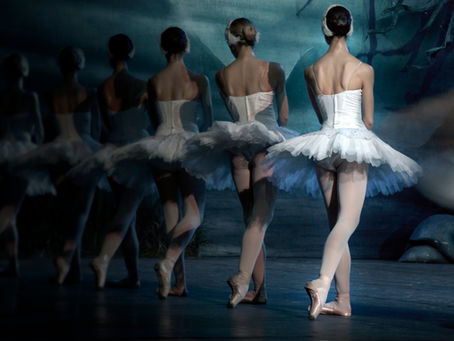top of page
Deep Dives, Not Overwhelm
Practical Solutions for Ballet Teachers



Why Your Students' Dégagés Look Like Grand Battements (And the Tempo Fix That Actually Works)
"Lower your leg in dégagé." You've said it hundreds of times, yet students keep doing low grand battements. The problem isn't the height—it's how they're executing the movement. Students using quads to lift can't moderate effort levels. Learn why slowing down dégagé (yes, really) builds correct technique faster than rushing through it incorrectly.
4 days ago5 min read


Teaching the Mixed-Level Pointe Class: Management Strategies for Safety and Success
Some ballet teachers insist combining pointe levels is never appropriate. Others point to economic realities at non-ballet-academies. The debate misses the key question: Can you do this safely with your specific students this year? Learn the honest assessment framework and practical strategies for teaching multi-level pointe classes successfully.
Nov 136 min read


How to Teach Expressive Movement in Ballet: Why Dynamics Matter
You've seen it: dancers who execute every step with technical precision but look robotic on stage. You've tried "feel the music" and "show more emotion," but nothing changes. The missing piece isn't more emotion—it's understanding dynamics. Learn how teaching quality of movement creates naturally expressive dancers.
Nov 65 min read


How to Create Structured Ballet Lesson Plans That Build Technique
Most ballet teachers put tremendous effort into individual lesson plans but still feel like their students aren't progressing. The problem isn't the planning itself - it's the lack of connection between today's class and the overall plot of the year.
The biggest mistake I see teachers make is planning each lesson in isolation. Today is planned, tomorrow will be planned, but the systematic progression that builds real technique never gets considered.
Oct 303 min read


Multi-Level Ballet Class Management: A Visual System That Actually Works
Managing multi-level ballet classes creates a constant dilemma: how do you group students appropriately without hurt feelings? My friend Nikkii Riley developed a brilliant visual system that solves this challenge through ribbons, flowers, and strategic leotard colors. Here's how to implement her approach in your own studio . . .
Oct 163 min read


How to Teach Ballet Posture Without Overwhelming Dancers
Teaching proper ballet posture can feel like walking a tightrope. Push too hard, and students become self-conscious. Don't address it enough, and poor habits become permanent. Here's how to introduce body alignment systematically without creating classroom stress . . .
Oct 22 min read


Arabesque Ballet Training: Building Inevitable Technique from Beginning Division Through Level 4
After 25+ years of teaching, I've learned that beautiful arabesque isn't something you suddenly achieve in center work—it's the natural result of systematic preparation that begins the moment students walk into your studio. Here's the complete warm-up progression that makes arabesque feel inevitable rather than impossible.
Sep 173 min read


Why Teaching Arabesque Should Start at the Barre (Not in Center)
Walk into any ballet class and you'll see students attempting arabesque with collapsed lower backs and wobbly supporting legs. Teachers spend countless hours trying to fix these issues, but here's the truth—by the time students reach center work, it's too late. The real solution starts at the barre with tendu.
Sep 103 min read


Defining Line in Ballet: The Essential Framework Teachers Need
'Fix your line' - but which line? The straight line of alignment? The curved path of port de bras? The illusion of extension in grand jeté? After years of research, I've defined the three types of line in ballet that every teacher needs to understand.
Sep 43 min read


Improving Pirouettes in Ballet: Why Artistry Training Transforms Technique
Your students have the strength and understand the mechanics, yet their pirouettes remain inconsistent. The missing piece isn't more repetition—it's intentional artistry training. When dancers control their eye-line during balances, their pirouettes naturally improve through enhanced spatial awareness and focus.
Aug 282 min read


Building Confidence in Dance Students: Why Celebration Points Transform Training
Talented dancers who second-guess every movement? The problem isn't their technique - it's how we recognize progress. Celebration points transform training by systematically building the confidence that makes higher standards achievable. When dancers see their growth, they approach challenges with excitement rather than fear.
Aug 143 min read


Teaching Artistry in Ballet: The Eye-line Approach That Actually Works
How do I make my dancers more artistic?" Most teachers avoid this question because they don't have a systematic approach. The solution lies in progressive eye-line development - using ancient brain systems to transform technique into storytelling communication at every age.
Jul 313 min read


5 Tips I Wish I'd Known as a New Ballet Teacher
The first time I taught class, I thought preparation meant knowing the vocabulary and having a few combinations ready. I was wrong. Teaching ballet is an entirely different skill set from dancing ballet. After 27 years, here are the five most important lessons I wish someone had told me before I taught my first class.
Jul 246 min read


Tips for Teaching Beginning Adult Ballet: The Smart Way to Introduce Turns
While children spin for fun and bounce back from tumbles, adult beginners approach turning with understandable caution. Changes in muscle strength, joint mobility, and reaction time all affect how joyful a first pirouette might feel. Here's why triplet steps beat pirouettes every time for introducing adults to the joy of turning.
Jul 173 min read


Clarity in Ballet Technique--Rond de Jambe
That frustrating 'clunk' in your students' rond de jambe? It's happening because they're playing connect-the-dots with ballet positions instead of moving smoothly through space. Here's how embracing 'the ugly place' transforms choppy ronds de jambe into flowing, effortless circles.
Jul 103 min read


From Paper Dolls to Full-Bodied Artistry: Teaching Spatial Awareness in Ballet Class
Every ballet teacher has seen them - technically strong dancers who somehow lack that compelling presence that makes you stop and watch. Here's the systematic approach that transforms paper doll dancers into full-bodied artists through intentional spatial awareness training.
Jul 33 min read


Teaching Artistry in Ballet: 9 Simple Ways to Transform Your Barre Work
Since I've spent the last dozen years researching and experimenting with artistry in ballet, integrating these elements into all levels has become second nature to me. Today I'm sharing some quick starting places with you
Jun 266 min read


Teaching Breath as Artistry in Ballet: Age-Appropriate Cues for Different Developmental Stages
If your breath cues work for some students but backfire with others, it's not your teaching—it's developmental readiness. This guide breaks down age-appropriate breath and plié cues from early elementary through high school, with practical "instead of this, try this" examples you can use immediately in class.
Jun 193 min read


When Plié Struggles to Bend: Addressing Ballet's Most Misunderstood Foundation Movement
When students struggle with plié, it's rarely just about 'not bending enough.' Discover how to address misconceptions about hip, ankle, and knee coordination that create choppy, tense pliés.
Jun 53 min read


Dance Teacher's Guide to Summer Thriving: Boundaries and Systems for Sustainable Success
After pouring energy into students all year, summer offers precious time to recharge and prepare. Discover how clear boundaries and efficient systems help dance teachers truly thrive without burning out.
May 292 min read
bottom of page